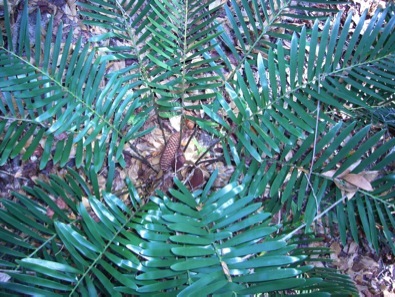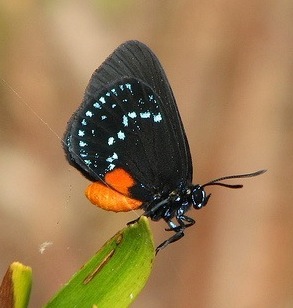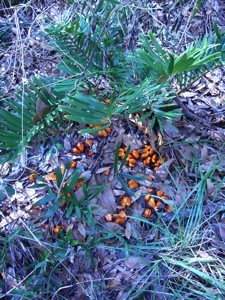Zamia Floridana: Making Toxins Edible
This plant is included here in case 1) society falls apart; 2) You live in Georgia or Florida and need starch desperately or 3) someone wants to trade this starch with you. The plant is the Coontie and it can kill you. It can also sustain you. Don’t be surprised that it is toxic without processing. Many foods are. Tapioca comes to mind as do cashews, and pokeweed.
When there were few people and a lot of Coontie it was not only a major source of starch (flour) for local Indians in Florida but it was a commercial product with at least eight businessmen producing it for about a century, from around 1836 to 1925. One such mill sat at the corner of now Southwest 104th Street and US1 in Miami. One mill processed up to 15 tons per day. Harvesting and urban sprawl brought the Coontie to the edge of disappearing.
In the fossil record, the Coontie family –Cycads — the clan goes back to the dinosaurs, some 325 million years or so experts say. They were the dominant plant species. The Coontie is the only member of that family in the United States. They are slow growing taking three decades to reach a five-pound weight. Coontie are fertilized by two beetles and they are the only place the brilliant Eumaeus alata butterfly, left, lays its eggs. (Listen to this bureaucratic nonsense: The butterfly was thought extinct by 1965 thus by governmental thinking it cannot be protected even though it is in reality very rare and almost extinct. Because it was not thought to be around it was not and is not covered by endangered species laws. Said another way it is not on the protected list because they thought it extinct and now that it is not it can’t be put on the protected list… Yes, that is totally irrational but there it is.) Coonties are now a common native landscape plant, replacing the natural population. Thus it is quite common if one needs to find it. Clearly this is not a plant you eat for the fun of it. It is a staple when one really needs it and time is not an issue. Time?
Coontie requires processing that includes leaching and fermentation. Interestingly, fermentation and or the action of enzymes on a food is common and makes a few non-edible foods edible. Many native populations crushed the seeds of the Prunus clan to make them edible after “curing” gets rid of harmful chemicals. The seeds of the Chickasaw Plum are an example as are sloes.
Here is an except from: Starch Making: A Pioneer Florida Industry By Mrs. Henry J. Burkhardt: No date was given.
“Mr. Mettair’s mill was probably a replica of those 1870 mills where no doubt, he had worked as a young man. His grinder was a log of pine, turned to be exact, and spiked diagonally with nails for grinding. The coontie roots were soaked over night and after grinding were fed into a hooper or deep box and from there put through a strainer rubbed constantly with running water. It was washed for two hours, the starch dropping to the bottom where a hole at what was called “starch level” drained away the water…. The wet starch was packed into barrels to be washed again three times, while stirring and settling. It was allowed to reach the bubbling stage in fermentation for then all dirt and sugar came out. The residue from this “yellow contie” was cooked and fed to the pigs, making another useful by-product. William Mettair, the oldest son, and inventor of the family, in 1904 devised a revolving strainer which eased the manual labor, resulting as well in a purer product. The finished starch was spread out on canvas driers and kept broken up until completely dry, before it was packed into barrels for shipment. It required one ton of coontie root to make 200 pounds of starch through this process.”
And another account: Daily National Intelligencer, Washington, on Thursday, February 25, 1836. Original donated to Fort Lauderdale Historical Society. The following text is exactly as it appears in the original: From the Charleston Courier, sketches of the peninsula of Florida by Dr. Strobel:
“As we approached New River, the land upon our right consisted of the same sandy pine barren as I have already described. The Indian arrow root, called coonte, is found here is great quantities. We landed, and collected several roots, which were very large, weighing several pounds. This is the Indian’s principal bread stuff. It is met with in most of the pine barrens in this section of Florida, but it grows in such profusion in this neighborhood, that they come from considerable distances to procure it. Mr. Cooley … was engaged in the manufacture of this article, and had brought it to great perfection.
“The following is the manner of preparing it: A sufficient number of roots being collected, they are peeled, washed, and grated, in the same manner as potatoes, and thrown into large tubs of water. After remaining in soak for a certain length of time, the water is stirred and strained: by this process it is greed of the feculent matter. The coarser portion, thus separated, may be given to hogs, whilst the finer portion, which passe through the sieve, is allowed to settle. The farina, which is almost insoluble in cold water, subsides at the bottom. The water is drawn off, and the yellow portions which remain on the top are removed. The white arrow root, which from its specific gravity, is found at the bottom, is collected, and repeatedly heated with fresh water, until it becomes perfectly pure and white, of a granular, glistening, crystalline appearance. I am inclined to think that , when thus prepared, it is very nearly, if not quite equal, to the Bermuda arrow root, not only as a starch, but also as an article of diet.”
Dr. Strobel was where Ft. Lauderdale is now and in fact Coontie production created the city. In 1836 the Indians basically attacked all such processing places between there and St. Augustine (makes sense since it was their food staple.) They killed everyone but Mr. Coolie mentioned above who was away at the time. In response Major William Lauderdale and his Tennessee Volunteers built a fort where the city would one day be. The rest is spring break history.
And here is a University of California report:
“The plant parts contain central nervous system toxins [cycasin] which must be removed before consumption. To make flour, the roots are first chopped into pieces. They are then pounded with a mortar and pestle. The pulp is then washed with water and the starch is allowed to settle to the bottom. Then the water is drained and the remaining paste is left to ferment for several days. At the end of the fermentation process, the starch is set in the sun to dry. When dry, the powdery, cornmeal-like flour is then baked into bread.”
No, I haven’t tried it. But, if I come across a Coontie marked for destruction I might. But consider: One of DeSoto’s men died from poorly prepared coontie bread and Union soldiers in the Civil War in Florida also died from eating coontie bread… though come to think of it that could have been intentional. The wash water, by the way, is toxic.
There are actually several species of “Coonties” in Florida, or not. The botanists cannot agree. The scientific name for the Florida Coontie is Zamia floridana ( ZAY-mee-uh flor-rid-DAY-nuh) or Zamia furfuracea (ZAY-mee-uh fer-fer-AH-see-uh) or Zamia integrifolia (in-teg-ree-FOH-lee-uh) or Zamia pumilia (ZAY-mee-uh POO-mil-uh) though latter might be from the Dominican Republic. Zamia means “pine nuts” because the fruiting bodies of the Coontie resemble pine cones. Fufuracea means mealy or with scales, integrifolia means leaves undivided, floridana of Florida, pumilla small or dwarf. The Zamia chigua (ZAY-mee-uh CHEE-gw) of Central America has been used for food as well. Chigua is the local name of the plant. Coontie is from the Creek (Seminole dialect) word kontí (KOON-tee) and means “white root” or “white bread.” Cycads come from the Geek word kyklas and means “palm.”
For pollination the Coontie cones provide food the beetles Pharaxonotha zamiae and Rhopalotria slossoni. The seeds are a source of food for mockingbirds, blue jays, and small mammals. Butterfly larvae feed on the leaves. Eumaeus (YOO-mē’us ah-LAY-tuh) was the faithful swine herd of Odysseus , and altata (ah-LAY-tuh) means winged. Winged Swine Herd… well, a butterfly has to be called something. See photo above right.
Coontie is protected from collection from the wild. I think that would exclude cultivated plants and if society fell apart. The orange outer layer of the seeds is also toxic to touch (having the same toxin as the roots and leaves.) They are considered not edible. However, there is one report that if the seeds are peeled of the orange coat, ground, and leached like the roots they are edible. I would not bet my life on it. Toxicology expert Dr. John Kinsbury says they are thought to be toxic for humans.
Green Deane’s “Itemized” Plant Profile
IDENTIFICATION: A fern-like evergreen, shrub, one half to 1 yard in high with a thick sometimes branched, trunk that is either very short or underground. Dark green fronds grow from the top of the trunk, 2 to 13 pairs of stiff, leathery leaflets. Green to dark reddish brown cones grow on stalks, from the center of the top of the trunk. The red to red-orange seeds are not edible and are toxic to touch.
TIME OF YEAR: When ever the trunk is large enough to have a large amount of starch. Reduction is 10 to one. One hundred pounds of Coonti produces 10 pounds of processed starch.
ENVIRONMENT: Rich, moist, well drained soil, hammocks and pine lands. Prefers some shade.
METHOD OF PREPARATION: Extensive: Must be cleaned, peeled, mashed, washed, settled, fermented then dried or used as a mash in soups et cetera. The seeds are not edible and are toxic to touch. A blue-green algae on the roots is natural and a symbiotic relationship with the algae providing nitrogen for the Coontie. The roots are 38% starch and 6% protein. With the processed starch the Seminoles made a thick gruel called “sofkee.”





I am reading about the Seminole Indians who lived off this root . I hope you try it some day and report. This could be a possible food in hard times.
I am enjoying Lambs Quarters now in Brooksville,the best spinach I’ve grown
k
Is there anybody out there who has actually made flour and bread? Please respond…..Mac Steen
I’ve eaten the flesh off the red berry, it is sweet and reminds me of crayons. I’ve had no such bad effects from eating it.
Perhps not today but the research showed a significant increase in Alzheimer’s disease decades later in those who ate them.
I’m researching this plant after we found a female cone and broke it open and I ate a seed. I agree with Liquid Awesome’s description of it as “like crayons.” Except it was sweet. I was reminded of Durian, and figured it was some kind of wild durian before deciding to try it.
Here’s what I found researching Cycasin, the alleged poison:
Human Toxicity Excerpts:
DURING 1959 NATIVES OF MIYAKO ISLANDS, OKINAWA, SUBSISTED MAINLY ON CYCADS. CANCER MORTALITY &…HEPATOMA MORTALITY IN THESE ISLANDS BETWEEN 1961 & 1966 DID NOT DIFFER SIGNIFICANTLY FROM THAT IN INTERIOR OF JAPAN & DID NOT INCR APPRECIABLY OVER THAT PERIOD. /CYCADS/
[IARC. Monographs on the Evaluation of the Carcinogenic Risk of Chemicals to Humans. Geneva: World Health Organization, International Agency for Research on Cancer, 1972-PRESENT. (Multivolume work). Available at: http://monographs.iarc.fr/ENG/Classification/index.php p. V10 129 (1976)] **PEER REVIEWED**
A CARCINOGEN OF WHICH AGLYCONE, METHYLAZOXYMETHANOL, IS ACTIVE COMPONENT…
[The Merck Index. 9th ed. Rahway, New Jersey: Merck & Co., Inc., 1976., p. 352] **PEER REVIEWED**
Despite the known human ingestion of cycad nuts; evidence that cycasin causes human liver disease has been scant, perhaps because the populations that eat the cycad nut have learned to process the fruit in a manner that removes the toxin. Nevertheless; a recent report from Japan described a small epidemic of acute hepatic injury attributable to the ingestion of cycad nuts, and this toxic plant warrants being included among the domestic hepatotoxins.
[Haddad, L.M., Clinical Management of Poisoning and Drug Overdose. 2nd ed. Philadelphia, PA: W.B. Saunders Co., 1990., p. 272] **PEER REVIEWED**
Exposure to cycad seed kernel is an etiologic factor for the western Pacific amyotrophic lateral sclerosis and parkinsonism-dementia complex. Traditionally processed cycad flours (n = 17) obtained from Chamorro residents of Guam and the adjacent island of Rota at risk for neurodegenerative disease were extracted and analyzed by high-performance liquld chromatography for content of beta-N-methylamino-L-alanine and methyl-azoxymethanol beta-D-glucoside (cycasin). Cycasin (detection limit: picomole) was present in concentrations of 0.004 to 75.93 ug/g (mean, 12.45 + or – 5.0 ug/g) and levels of beta-N-methylamino-L-alanine (detection limit: subpicomole) ranged from 0.00 to 18.39 ug/g (mean 5.44 + or – 1.56 ug/g). On average, cycasin content was approximately 10 times higher than that of beta-N-methylamino-L-alanine. The largest concentrations of cycasin were found in samples from villages with a high reported prevalence of amyotrophic lateral sclerosis/parkinsonism-dementia complex. Ingestion of cycad-derived food would result in estimated human exposure to milligram amounts of cycasin per day. The cytotoxic properties of cycasin merit consideration in relation to the etiology of western Pacific amyotrophic lateral sclerosis/parkinsonism-dementia complex.
[Kisby GE et al; Neurology; 42 (7): 1336-40 (1992)] **PEER REVIEWED** PubMed Abstract
We have these in our yard. Originally I did think that they were edible, but then I did some research and found out otherwise. I, for one, would not be willing to try it at all unless I had no other options at all. Even at that point, the amount of energy necessary to process it to a non-toxic point seems to be vast in comparison to the meager payload in the end.
On the other hand, I’d be interested to know the lifespan of the Indians who ate this stuff. This is why this kind of thing fascinates me so much — how many people died before they figured out how to make it non toxic, and who in the world kept trying until the point that it was? 🙂
Well… three things could have happened, in my thinking. One is that the medicine man was looking for medicines and in the process discovered the fermented, washed root was edible. Some noticed animals eating the rotting watersoaked root did not die. Or hunger forced a lot of people to keep trying over the years.
The people who became the Seminoles (SE native people who moved into Florida after the original people were gone) were used to processing catbrier root – they called it “Coontie” in the various Muscogean dialects — so looked for something as common and nutritious when they were pushed into Florida by the European settlers and the US.
Catbrier “coontie” is also called red coontie (vs. white coontie from Zamia). It’s processed very similarly, but not to remove toxins – simply to make it less woody and taste better (it tastes like dirt, literally, if you don’t leach it).
It was used as a starch, thickening agent, and especially to feed babies and the elderly or sick, as it is very highly digestible. We do the same thing with tapioca starch now…or did when I was a kid.
I’ve eaten coontie (red and white) in bread, mixed in stews, and just rehydrated. It doesn’t have much taste by itself (again, like tapioca). Adding hickory milk or berries makes it taste better.
So…. you are saying “red coontie” was prepared Smilax starch, which is pink, and “white coontie” was made form Zambia (after much processing to remove the cyanide.)
We have one of these in our yard. It is so lush and beautiful that I wanted to keep it even though it is not immediately useful. What you said about the butterflies convinced me. Thanks again!
Can you tell me where I can buy “Coonti Flour”? I live in Florida.
I doubt it is on sale anywhere. It is toxic unless processed and there is probably a lot of liability associated with it.
Deane
Neighbor has what appears to be a coontie. Loose atop the plant
are several dark brown nuts w/ loose thin skin. They’re about the size and shape of a walnut. What is this thing ??
Thanx, Turk
Perhaps it is a low sago palm.
I have handled the seeds and fruits and didn’t know they were toxic to the touch… nothing happened, but I also do not react to poison ivy… my family has immunity.
No one is immune to poison ivy. They just have a higher resistance. Each exposure reduces that resistance. Keep playing with it you will get it
I met aperson who survived the food shortages during world wars due to his mother fixing bread and cereal for the family using the plant. AT 85 he has cancer but is grateful for a long and productive life.